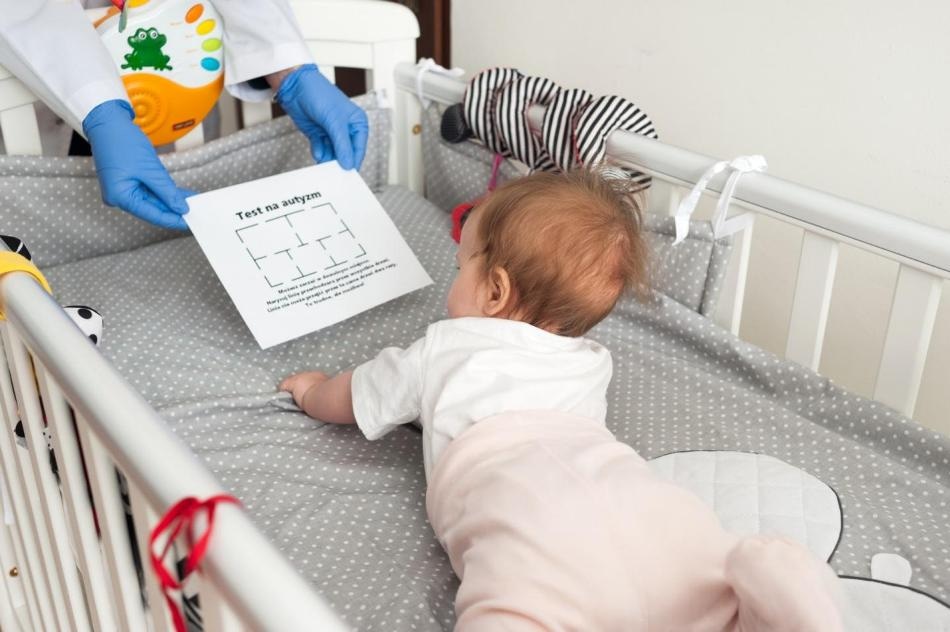Nov 16 2017
Will it be possible to detect features of autism at birth? This may become a reality with a new sensor designed at the Institute of Physical Chemistry of the Polish Academy of Sciences in Warsaw.
A polymer layer with a carefully designed structure is the main recognition element of the new device. It recognizes oxytocin molecules, a compound believed to be one of the biomarkers of autism.
 Small amounts of oxytocin, one of the biomarkers of autism, can be detected by a new chemical sensor, designed and fabricated at the Institute of Physical Chemistry of the Polish Academy of Sciences in Warsaw. Credit: IPC PAS, Grzegorz Krzyzewski
Small amounts of oxytocin, one of the biomarkers of autism, can be detected by a new chemical sensor, designed and fabricated at the Institute of Physical Chemistry of the Polish Academy of Sciences in Warsaw. Credit: IPC PAS, Grzegorz Krzyzewski
Molecules of numerous different chemical compounds circulate in human blood. Oxytocin, a compound more commonly called the 'love hormone', is one of them. Distinct changes in its blood concentration suggest that the patient may possibly be predisposed to autism. These changes can be detected by using a new chemical sensor that selectively identifies even small quantities of oxytocin. This sensor was designed and produced at the Institute of Physical Chemistry of the Polish Academy of Sciences (IPC PAS) in Warsaw.
An explanation of work on the device, supported by the Ministry of Science and Higher Education of Poland through the Iuventus Plus grant, has been published in Biosensors and Bioelectronics, a scientific journal of great reputation.
In medicine, there are rare breakthroughs that lead to a qualitative improvement in the health of entire populations. In the 20th century, these moments include the discovery of several antibiotics or the spread of vaccination. At present, it seems that a revolution on a similar scale will occur in the near future thanks to new diagnostic devices that are fast, accurate, sensitive, and above all small and very inexpensive.
Available to everybody and at all times - perhaps even wearable or integrated in everyday items - these instruments could detect diseases at very early development stages, thus contributing to a considerable increase in the efficacy of treatment. The key element of this kind of innovative diagnostic instrument should be reliable sensors that can react to the presence of even a small amount of molecules of highly discriminative with regard to selected chemical compounds.
In the devices developed in our research team, the role of recognizing the sought after compounds is played by carefully fabricated and equally carefully produced polymer layers. The main idea here is simple, i.e., for each compound to be recognized we try to build a layer of a polymer with cavities - molecular voids - that are as best as possible suited to the shape as well as physical and chemical properties of the molecules of the chemical compound that we want to recognize in the sensor's surroundings.
Prof. Wlodzimierz Kutner, IPC PAS
'Stamping' the properties and shape of molecules of the chosen compound in the polymer matrix is a method called molecular imprinting. Functional monomers are brought into a solution consisting of the molecules that are to be detected. They attach to characteristic binding sites on the molecules to be imprinted. Then, a cross-linking monomer is introduced which quickly binds to the functional monomers. The target recognition layer is developed after polymerization of the cross-linking monomer, and next rinsing out from the structure thus formed the molecules of the compound chosen for detection.
Prof. Kutner's group has already developed several polymer layers that selectively respond to even low concentrations of important chemicals, including albumin, nicotine, melamine, and neopterin (one of the cancer biomarkers). Oxytocin has now joined this group.
It's one thing to capture oxytocin molecules in a polymer layer, but quite another to read the information that the molecular cavities have been filled. For us, the signal of the presence of oxytocin in the recognition layer is a change in electrical capacitance. That is why we produce these layers on small gold electrodes. We insert the electrodes into a tube through which a solution of blood (in our tests artificial blood) flows. The oxytocin molecules sink into the cavities of the polymer layer, thus changing the electrical capacitance of the measuring system.
Dr. Zofia Iskierko from Prof. Kutner's team
In experiments, it turned out that the newly developed sensor detects micromolar concentrations of oxytocin and responds to its presence even when it is encircled by molecules of a very similar structure. Professor Kutner's group is working to increase the sensor’s sensitivity to a level that enables detection of nanomolar concentrations. Here, the goal is to attain a sensitivity that enables a small, single drop of blood to be used to perform a range of diagnostic tests. The experiments carried out at the IPC PAS labs also revealed that the polymer recognition layer is comparatively durable and enables numerous measurement repetitions without detriment to their selectivity and sensitivity.
Changes in blood oxytocin concentration alone will not make it clear whether an individual is predisposed to autism. The concentration of at least a small number of other substances (biomarkers) typically associated with this disease must be checked before performing the diagnosis.
Our oxytocin chemical sensor is really only a first step towards building a more advanced medical device that diagnoses a predisposition to autism. For some time, we have been working on polymer layers that respond to the presence of two other compounds associated with autism, namely, melatonin (which should not be confused with melamine) and gamma-aminobutyric acid.
Dr. Piyush S. Sharma, Leader of the Research Project, IPC PAS